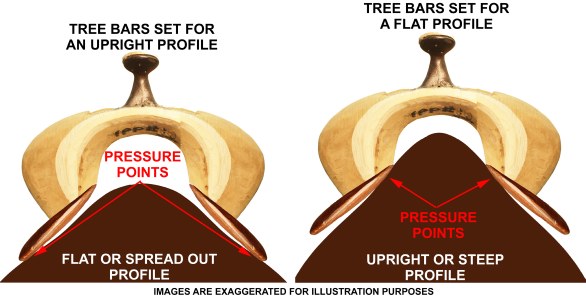BAR ANGLE
|
|
The bar angle is the defining element of the tree as to saddle fit with swell gullet width, twist, rock, flare, crown, relief, length, pattern and channel as secondary elements. The bar angle is designed to correspond to the slope of the “saddle pocket” on a horse located below the withers and back of the shoulder blade.
If the angle is incorrect none of the other measurements or padding can compensate for or correct a negative fit.
BAR ANGLE -- UPRIGHT or STEEP PROFILE
The following is the analysis of bars with an upright or steep angle and different gullet widths on two body types.
|
|
 In the above example, the bar angle and the slope of the body type are compatible. The gullet width has no effect on how the saddle fits the horse other than fine tuning the fit. No matter what gullet width is used, the fit is still within acceptable limits in regards to the bar angle. Depending upon the situation the gullet width may be changed to move the bars higher or lower on the horse to level the saddle or
"sweeten the fit". The tree with a 6 1/4" gullet width seems a little high on the wither and the saddle may be riding up hill, so a wider gullet width could level the saddle.
|
|
 In the above example, the bar angle and slope of the body are not compatible. The gullet width does not improve the fit and the swell is "perched up" on the bottom of the bars. The pressure point is only moved up or down on the horse.
|
|
BAR ANGLE -- WIDE ANGLE
The following is the analysis of a flat or spread out bar angle and different gullet widths on two body types.
|
|
 As with the previous example, indicates that the bar angle and the slope of the body type are compatible. The gullet width has no effect on how the saddle fits the horse other than fine tuning the fit. No matter what gullet width is used, the fit is still within acceptable limits in regards to the bar angle. Depending upon the situation the gullet width may be changed to move the swell higher or lower on the horse to level the saddle.
|
|
 The above illustration indicates that the bar angle and slope of the body are completely incompatible. The gullet width does not improve the fit. The pressure point is moved down as the gullet width increases.
When the bar angle is incompatible with the slope of the wither, a pattern emerges that can possibly be used in diagnosing a saddle fit problem. While a bar angle that has more degrees in the angle will tend to apply more pressure at the top portion of the of the bar ( SEE EXAMPLE 1 ). A bar angle that has less degrees in the angle will tend to apply more pressure at the bottom portion of the bar ( SEE EXAMPLE 2 ). So when a sore spot/white spot appears further down on the wither the problem could be bars with not enough degrees and a sore spot/white spot that appears towards the top of the wither the problem could be bars with to many degrees.
 |
FOOTNOTE A: The images are modified and exaggerated for illustration purposes. The actual measurements and differences are small and therefore are not easily discernable. The profiles of the body types are based on actual profiles. The crown on the front bar pad has been flattened because the flare and crown create a three dimensional view and when viewed in one dimension the result is distorted.
|
e-mail mailto:info@saddlemakers.org
Copyright 2005 - 2016 American Saddle Makers Association, Inc.
